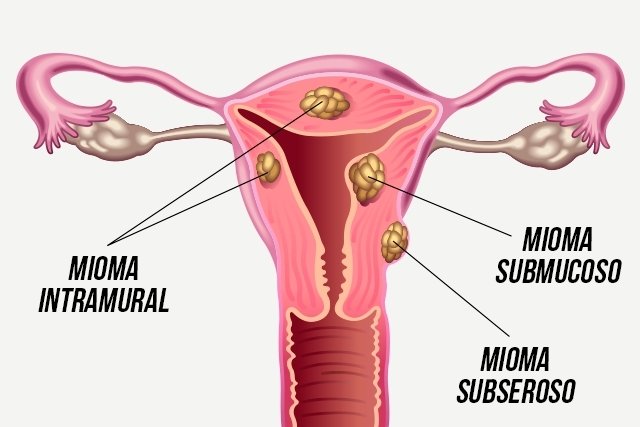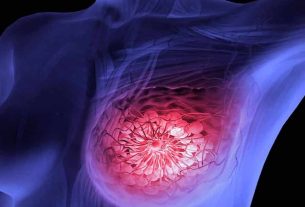Uterine fibroid is a type of benign tumor that forms in the muscular tissue of the uterus and can also be called uterine fibroma or leiomyoma. The location of the fibroid in the uterus can vary, as can its size, which can be microscopic or several centimeters long.
Fibroids are relatively common and, in most cases, do not cause symptoms, however some women may report cramping, bleeding or difficulty getting pregnant.
In these cases, the start of treatment may be indicated according to the gynecologist’s guidance and the characteristics of the fibroid, and the use of medication to alleviate symptoms or surgery to remove the fibroid or uterus may be recommended, in more serious cases.

Main symptoms
The main symptoms of myoma are:
- Intense cramps;
- Pain during sexual intercourse;
- Symptoms of constipation;
- Longer menstrual period.
In most cases, uterine fibroids do not lead to the appearance of signs or symptoms, however, when the fibroid is large or when several fibroids are found in the uterus, it is possible to notice the appearance of symptoms, and it is important that the gynecologist is consulted. See other symptoms of uterine fibroids.
How the diagnosis is made
The diagnosis of myoma is made by the gynecologist through a physical examination, which involves a gynecological examination and palpation of the abdomen. If the woman presents symptoms or changes identified during the clinical examination, the doctor may recommend an abdominal or transvaginal ultrasound.
Make an appointment with the gynecologist in the region closest to you:
Furthermore, in some cases, the doctor may request more specific tests, such as hysteroscopy, sonohysterography and hysterosalpingography, for example, which are important to evaluate the uterine cavity.
Causes of fibroid
Myoma does not have a very well-established cause, however it appears when the cells of the muscular tissue that form the uterus multiply in a disorderly way, leading to the appearance of the tumor. It is possible that this disordered proliferation is also related to the woman’s hormonal changes, because the symptoms usually appear in adult women and regress after menopause.
Furthermore, myoma symptoms may also appear more frequently in women who take hormone replacement therapy.
Women who are most likely to have fibroids are those who do not have children, those who have a diet rich in red meat and low in vegetables, obese women and those who have a family history of this disease.
Types of uterine fibroid
Myoma can be classified into different types according to where it develops in the uterus, the main ones being:
- Subserousin which the fibroid develops in the outermost part of the uterus;
- Intramuralwhen it appears within the walls of the uterus;
- Submucosowhen it develops internally, within the cavity of the uterus.
Knowing the type of fibroid is important so that the severity of the fibroid can be assessed and the need to start treatment immediately afterwards. Find out more about the types of fibroids.
How the treatment is carried out
Treatment is indicated when a woman has intense symptoms, such as a lot of pain or heavy menstruation, or when she is trying to get pregnant without success. The type of treatment depends on the symptoms, size and type of fibroid in each woman, and must be guided by the gynecologist, and may be recommended:
- Use of anti-inflammatoriessuch as Ibuprofen or Naproxen: improve intense menstrual cramps and reduce excess bleeding caused by fibroids;
- Use of hormonal medicinessuch as the pill: help to alleviate the intensity of menstruation and reduce the size of the fibroid;
- Iron supplements: prevent and treat cases of anemia caused by excessive bleeding;
- Surgery, known as myomectomy: it serves to remove the fibroid, without having to remove the uterus. It is used especially when the fibroid presses on other organs or causes very intense symptoms;
Furthermore, when the fibroid is very large, it may be necessary to reduce its size before surgery, and for this purpose a technique known as embolization is used.
Read too: Myoma surgery: when it is indicated, how it is done, risks and recovery
In it, the doctor, through a surgical procedure, makes several injections with an embolizing agent diluted in iodinated contrast through the femoral artery, until a reduction in blood flow in the artery that nourishes the fibroid is observed, causing its death.
When a woman has a fibroid and no longer plans to get pregnant, the doctor may recommend removing the uterus to eliminate the fibroid and prevent the tumor from forming again. See more details on myoma treatment.
Does myoma make pregnancy difficult?
Some women who have fibroids may have difficulty getting pregnant, because the fibroid can cause some deformities in the internal part of the uterus, as well as changes in circulation and increased inflammation.
In these cases, it is possible to undergo treatments with hormone-based medications, such as estrogens and androgens, or surgeries, such as myomectomy or fibroid embolization, to increase the chances of becoming pregnant. See more about the treatment of myoma during pregnancy.
Bibliography
- DEBRAS, E et al. Fibroid and infertility. EMC – Gynecology-Obstetrics. 58. 1; 1-12, 2021
- PORTUGUESE SOCIETY OF GYNECOLOGY. National Consensus on Uterine Fibroids. 2017. Available at: <http://nocs.pt/wp-content/uploads/2018/10/miomas-uterinos.pdf>. Accessed on Aug 30, 2022
- HERNANDEZ, Valencia et al. Uterine myomatosis: implications for reproductive health. Ginecol Obstet Mex. 85. 9; 611-633, 2017
- FEDERAL UNIVERSITY OF CEARÁ. UTERINE MYOMATOSIS. 2021. . Accessed on Aug 30, 2022




